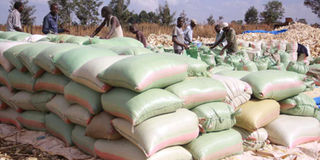To be food secure, we must address postharvest losses

Workers packing maize into sacks after shelling at a farm in Kabobo village, Uasin Gishu County .PHOTO |FILE
What you need to know:
- We stand to lose maize worth about Sh32 billion due to post-harvest losses, slow reaction, poor coordination and communication between State Departments of Agriculture at the county level
The annual demand for maize is about 50 million bags
Shortages and high prices continue to characterise Kenya’s food security status.
The country is just smarting from the 2016 food shortage and a deficit gap that was met by maize imports.
However, we seem not to have drawn lessons, and this year, we stand to lose maize worth about Sh32 billion due to post-harvest losses, slow reaction, poor coordination and communication between State Departments of Agriculture at the county level. Post-harvest losses, poor coordination and input market distortions are key issues that need to be addressed if the country is to reduce food security risks.
The annual demand for maize is about 50 million bags. This is far above the current stocks in the strategic grain reserves, imports, long rains harvest and the expected short rains harvest totalling about 36.4 million bags.
Major losses this year have been attributed to the fall armyworm infestation and post-harvest losses. Fall armyworm reduced the potential area under maize production in the country by about 200,000ha and this may increase during the short season period.
The pest was first reported in western in March. Delayed intervention services by agriculture extension services made the farmers to use trial and error methods in controlling the pest leading to faster spread.
This increased the cost of producing maize by 15 per cent in Kakamega County. Had there been timely interventions, the experience would have provided lessons for the high potential areas such as Trans Nzoia and Uasin Gishu as well as Machakos counties which all planted late.
Nakuru County reported the most efficient cost structure of maize production in 2017, thanks to use of timely and appropriate herbicides and mechanisation.
According to the Ministry of Agriculture, post-harvest losses arising from maize production account for 12 per cent of the total output.
Causes of post-harvest losses for smallholder farmers include lack of resources, inadequate access to better processing facilities, bad weather, poor production practices/planning, bad transportation facilities and lack of infrastructure, premature harvesting, lack of access to good quality packaging materials and technology and inadequate market systems.
High post-harvest losses reduces the amount of accessible maize in the grain market escalating the price. Further, the recent government action to raise the price of a bag of maize from the prevailing market price of about Sh2,500 to Sh3,200 per bag would not have a major impact on maize prices since only 1.8 million bags will be bought.
Unlike in the past when the price was set in early November, this year’s price was set in October and only a few farmers from Western Kenya are likely to benefit since they have already harvested.
Food insecurity will persist due to inability of urban poor to afford a package of 2kg of maize flour, which would retailing at about Sh112 and will be increasing from as early as January 2018.
Dr Otieno, Research Fellow Tegemeo Institute



